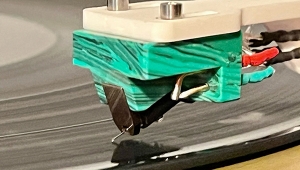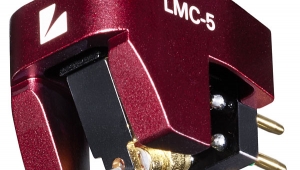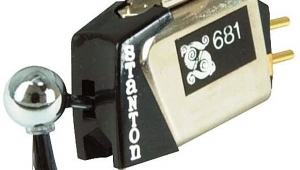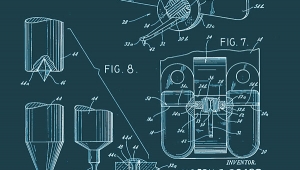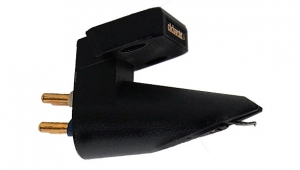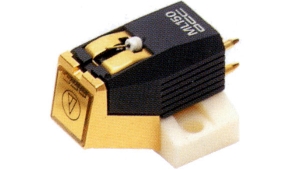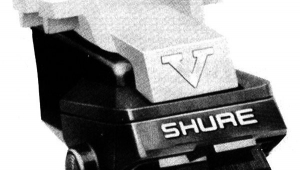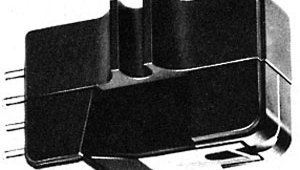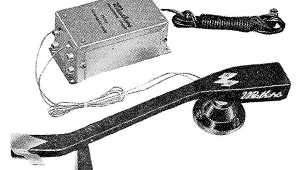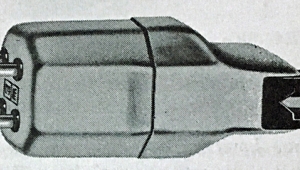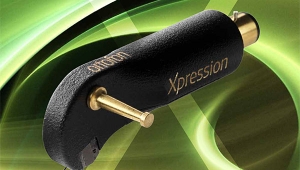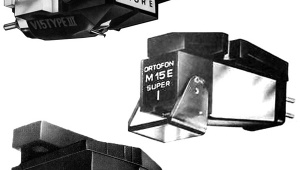| Columns Retired Columns & Blogs |
van den Hul Black Beauty MC phono cartridge Page 2
I began with the headshell more or less parallel to the platter and a VTF (vertical tracking force) of 1.35gm, as routinely used with the 'Hopper IV. A good place to baseline VTF with Grasshopper- and Black Beauty–series cartridges is to apply enough weight that the stylus emerges from the center of the hole in the pole piece (the front face of the cartridge) when under load in a moving groove. This may change over time as the suspension loosens up, so check it again after the cartridge fully breaks in. (van den Hul suggests 200 hours as about right, but you'll be hearing most of what the Black Beauty can do after about 60 hours of play.) After a little experimentation, I settled on 1.25gm of VTF for optimal tracking, focus, body, extension, smoothness, and tonal balance.
I set azimuth with the (unfortunately) now-discontinued Audio-Technica AT6020 Cartridge Analyzer and test LP. Best readings for lowest crosstalk between channels was found with the cartridge just a nudge from perpendicular as seen from the front.
Black is beautiful
The sound of the Black Beauty phono cartridge had a gestalt slightly different from that of the 'Hopper IV GLA I know so well. Where the IV is sharply focused, layered, startling, and dynamic, the BB was more round, almost opulent, with huge amounts of air and a very strong sense of the original recorded acoustic. While the Beauty's imaging was a bit less finely focused than the IV's, its imaging was convincing, even astounding at times in its own right. I found this to be a paradox of sorts. One usually associates air with transparency, but every rule needs its exception.
I was hugely entertained by the large, airy acoustic of Duke Ellington's Jazz Party. The palpability was greatly enhanced by the sense that the recording studio had been transposed into our listening space! (This was especially true with the Nagra VPA monoblocks.) It was awesome—the believability factor, if you will, was extremely high, and the room boundaries of the recording studio were perfectly explicated, as much sensed as heard.
The Ansermet Memorial Album was breathtaking in this regard, the air and sense of original acoustic highly involving and enjoyable. The "launch" of acoustics into this superbly re-created space seemed natural and unforced, the decay as fully developed as I've ever heard. It was fascinating to hear Ansermet scold and cajole the troops, and to listen for the change in acoustic between the rehearsal and the performance itself. Evidently vdH's "resolution-enhanced" description of this cartridge isn't hyperbole. Signal decay seemed to retain its integrity as part of the acoustic event, right down into the noise floor and below.
I suppose that that might be an element in the extraordinary sense of air I heard, textured and alive with sound and tonal color. In the past, I've described how individual boundary layers of air can surround performers on a soundstage, and noted how they relate to each other and the larger acoustic of the recording venue. With the BB, there was absolutely no sense of any grouping of individual air-layer boundaries. Rather, the "near-field" integration of the performers in relation to each other and the larger space was seamlessly presented as a single acoustic entity.
And it didn't take a large concert hall to make that apparent. Concentrating easily on the tonal color shimmering off Milt Jackson's mallets in The Modern Jazz Quartet, and especially Bags' Groove, the Black Beauty's integrity in replicating the acoustic delivered a vivid, natural, intimate sound. Even on close-miked female vocals, the air and space were remarkable. Cassandra Wilson on New Moon Daughter sounded exceptional—highly palpable and involving. The BB climbed all over female vocals like a randy gigolo anxious to please.
Harmonic development in the midband was also of the rich and textured variety. Now, my 'Hopper dishes out about as much as I consider seemly, the BB even a bit more. Is either "wrong"? Not on your life! It's a matter of taste, setup, and even associated equipment. The rich harmonics were a part of the heightened resolution characteristic, I'd say. Bloomy, rich, textured, nuanced—you won't be able to put the thing down! This was accompanied by lots of body. Corporeal? Don't ask and don't touch, because that's what you'll feel like doing to the wonderfully dimensional characters you'll suddenly find cavorting in your listening room.
Against the 'Hopper
Of course, life is all about compromise. There's no question that the Grasshopper IV is faster on the leading-edge transient, more "see-through" transparent and dynamic. The IV has more Startle Factor, and that I really love. The faster leading edge seems to pull the music along with a touch more verve and snap than the Black Beauty managed—the IV is a bit more on the pace. The BB wasn't slow by any standard, however. Along with its snappier transients, the IV is also more macrodynamic than the Beauty—partly due, I'd say, to the overall gestalt of the new cartridge, partly because of its slightly lower output. Don't scoff; that extra 1.5mV made for a perceptible boost in ballage, as it were, especially with the all-tube Balanced Audio Technology VK-P10 phono preamp.
Balancing that was the Beauty's superb ability with microdynamics, aiding and abetting the all-encompassing sense of air. Listening to the awesome bass on Dead Can Dance's Spiritchaser (4AD 46230-2) left me in no doubt that both cartridges handled the nether regions with power and aplomb. The BB was a little less quick and transparent down there, but actually dug deeper than the IV, and with slightly more heft and power.
In the highs, the Beauty proved alluring, sweet, and attractive, if a tad less incisive than the IV. The 'Hopper sounds more dynamic and extended, perhaps even a touch more linear, but the Black Beauty also embodied these same characteristics, if not quite so well as the IV does in some ways, and better than it in others. One is not less for being different from the other.
Then, too, I'm really splitting hairs. Believe me, these are two great cartridges; matched with the right system, they're both as good as it seems to get around here.
Beauty is more than skin deep
I think van den Hul has this right. Low-noise, high-gain, solid-state phono stages like the YBAs will get the best out of the Black Beauty, although the Nagra PL-P had more than enough clean tube gain. Given that, I still ever so slightly prefer the Grasshopper IV for its shimmer, pace, large-scale dynamics, and excitement. The Black Beauty sounds slightly more restrained, a little more harmonically fleshed out throughout the frequency band, and a touch more forgiving on top. Certainly its most endearing quality is the wonderful, breathable sense of air it drops over soundstage and listener with no apparent effort at all.
The Black Beauty has a little more Koetsu in its soul than the 'Hopper IV, along with an equal dollop of vdH family values like extension, linearity, speed, transparency, imaging prowess, and air. The vdH is no Koetsu, however, and that works both ways. If anything, other than its close relation the 'Hopper IV, the Black Beauty reminds me of the Wilson-Benesch Analog, a cartridge close in price and similar in sound. Of the two, the new van den Hul gets the nod for its refinement and top-to-bottom integration.
As they say on the TV Food Network, it's all a matter of taste. Highly entertaining, highly musical, highly recommended. Keep those analog fires burning.
- Log in or register to post comments
